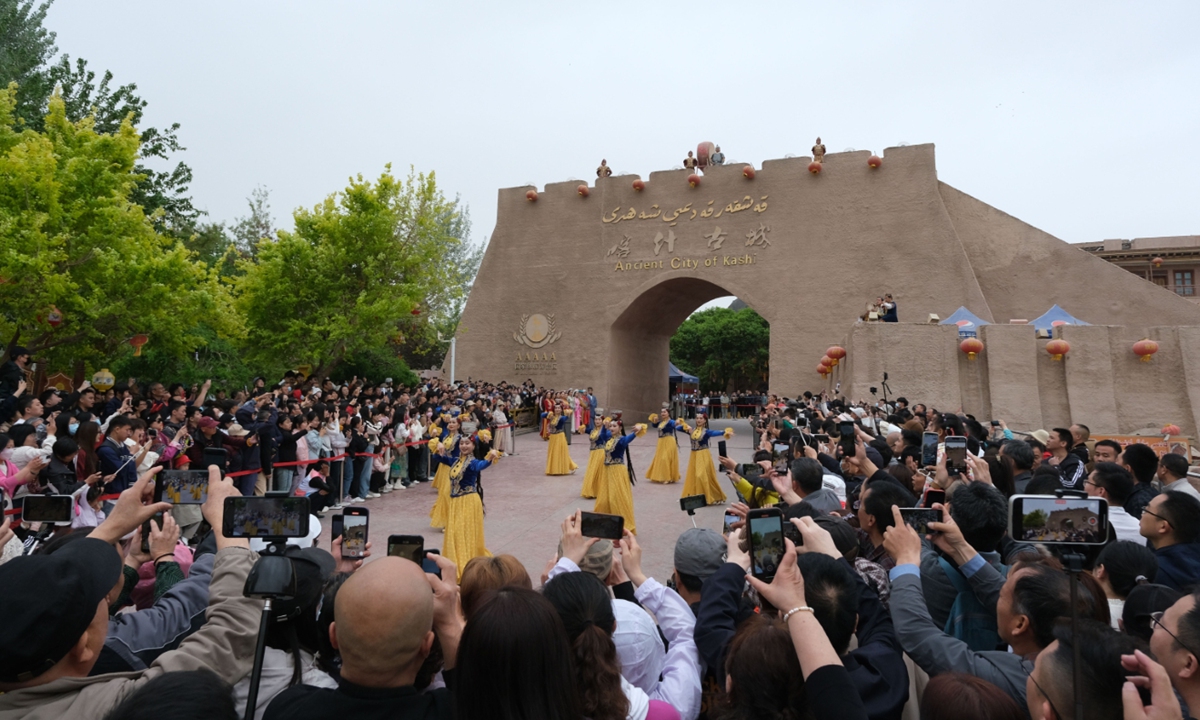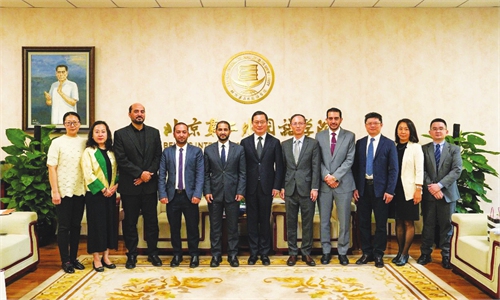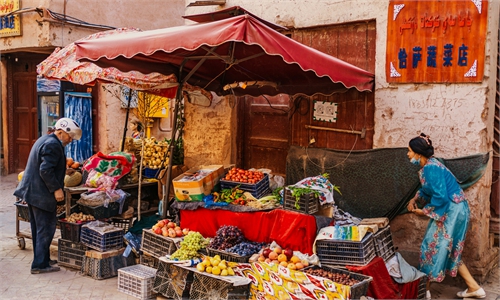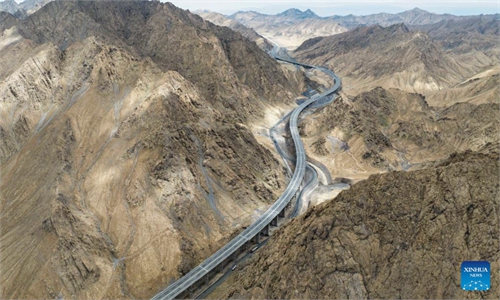
Tourists watch a performance at the gate-opening ceremony at the Ancient City of Kashi in Northwest China's Xinjiang Uygur Autonomous Region. Photo: VCG
Kashi, a 1,000-year-old city in Northwest China's Xinjiang Uygur Autonomous Region, boasts a rich ethnic flavor and deep cultural heritage. The historically significant commercial hub on the ancient Silk Road, which continues to serve as a crucial junction for the economies and cultures of the East and West, welcomes guests from around the world.
On Wednesday morning, over 170 experts from China and abroad gathered in Kashi for an international forum, discussing Xinjiang's cultural heritage and development.
The forum, titled "The History and Future of Xinjiang, China," was jointly organized by Minzu University of China, Peking University and Kashi University, attracting international experts from different countries such as the US, Australia, Germany, Italy, Hungary, Egypt, Russia, Mongolia, Kazakhstan, and Uzbekistan engaged in in-depth discussions.
"Xinjiang has always been a region where multiple ethnic cultures coexist. The innovation and exchange of various ethnic cultures have thrived in the fertile soil of Chinese civilization and are an integral part of Chinese culture," Erkin Tuniyaz, a deputy secretary of the Party Committee and chairman of the Xinjiang Uygur Autonomous Region, stated in his keynote speech.
"I think what's exciting, especially in Xinjiang, is the respect for minority people. This is what makes this region so unique as the conference noted," Mary Tucker-Grim, a professor of School of Forestry and Environment Studies of Yale University, told the Global Times.
Indispensable since ancient times
Since ancient times, Xinjiang has seen various ethnic groups writing an epic of migration, settlement, and cultural exchanges over the centuries.
Exchanges between Xinjiang and the Central Plains region began as early as the pre-Qin period (221BC-206BC), with routes such as the Jade Road, Painted Pottery Road, Millet Road, and Wheat Road taking shape through these interactions.
The excavation of the Dun ancient city ruins dating back to Tang Dynasty (618-907) corroborates the historical facts of multi-ethnic integration, multi-religious coexistence, and multicultural compatibility along the northern slopes of the Tianshan Mountains from the Tang Dynasty to the Yuan Dynasty (1279-1368), said Wei Jian, a professor at the school of Ethnology and Sociology of Minzu University of China.
"These findings provide vivid and solid material evidence for the study and interpretation of the cultural exchanges between East and West on the Silk Road, the integration of multiple ethnic groups, and the formation and development of a unified grand pattern," Wei noted.
Carry on legacy
Located in the heart of the Eurasian continent, Xinjiang covers approximately one-sixth of China's total land area. Domestically, it borders the Xizang Autonomous Region, Qinghai Province and Gansu Province, while internationally, it shares borders with eight countries: Mongolia, Russia, Kazakhstan, Kyrgyzstan, Tajikistan, Afghanistan, Pakistan and India. It is the Chinese provincial administrative region with the most neighboring countries.
Its unique geological position makes it a vital corridor for trade and cultural exchanges, connecting ancient China with Central Asia, the Middle East and Europe. The region functioned as a "transit station" along the Silk Road, facilitating the exchange of goods, ideas and culture between diverse civilizations.
Since the dawn of humanity, people have been seeking ways to achieve mutually beneficial exchanges with others. The Silk Road is one of the greatest commercial routes connecting the China and Eastern Europe, said Mohsen Mohamed Negm-eldin, dean of the School of Archaeology at Cairo University as well as visiting professor at Shandong University and Nanjing University.
Despite the long distance between the starting point of the Silk Road, China, and the end point, Egypt, the two countries share many common civilizational characteristics, added Negm-eldin. "It can be said that China and Egypt are the two sides of the same coin."
Xinjiang's overall contribution to Chinese civilization and human development is far more significant than most historians have suggested and has a promising future, said Colin Mackerras, an honorary professor at Griffith University in Australia as well as chair professor at Renmin University of China.
Kashi was the city where the northern and southern Silk Roads met. The Silk Road has seen highly significant cultural interchange across the great Eurasian Continent. Like the rest of China, Xinjiang has undergone significant modernization.
Under the Belt and Road Initiative (BRI), Xinjiang's and Kashi's role as a hub for cultural and economic exchanges and development is growing more and more important. A bright future awaits Xinjiang, pointed out Mackerras.
In recent years, under the BRI, Xinjiang has seen continuous improvements in its economic and social development. Significant advancements have been made in various sectors, including infrastructure, science, education, culture and health. While Xinjiang serves as a crucial gateway for China's economic and cultural outreach through the BRI, it continues to carry its legacy from the ancient Silk Road.
"As a place where diverse civilizations converge, both the historical and future Xinjiang will adhere to the path of unity in diversity, building a safer and more harmonious Xinjiang. It will better serve as a hub connecting China with Central Asia, West Asia, and Europe, play a stronger supporting role in creating the core area of the Belt and Road initiative. It will also better protect the excellent cultures of various ethnic groups to enrich and develop the splendid and diverse Chinese civilization," said Pan Yue, a vice minister of the United Front Work Department of CPC Central Committee and head of the National Ethnic Affairs Commission.



